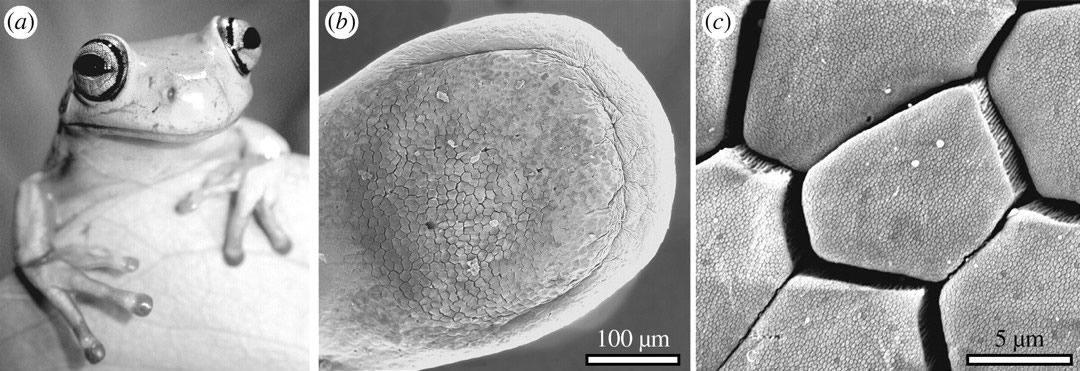A Sticky Solution
God Invented It First
What if we could design tape and adhesives that automatically cleaned themselves every time they got dirty or wet?
| Creation: | Tree Frog Feet |
|---|---|
| Technology: | Self-Cleaning and Underwater Adhesives |
Consider this—a tree frog hopping around the rain forest, crawling and sticking on any and all surfaces as he pleases. That’s when he hears a noise: a nearby snake is looking for a midnight snack. Acting quickly, the frog crawls underneath a leafy bunker to hide.
But then the unthinkable happens! The frog’s feet lose their grip. He slips and falls, becoming easy prey! At least, that’s what would happen if his feet were coated with household Scotch tape.
Try pressing a piece of adhesive tape against a dusty surface. Before long, the tape loses its grip as dust particles clog the sticky side.
Tree frogs hop around in dusty, wet, or muddy surroundings. Yet they must stick securely to branches and leaves—even hanging upside down—for their entire lives (eight to ten years). How can they hold onto muddy, wet surfaces without eventually falling?
Researchers are testing how this “sticky” ability works. To figure out how tree frogs crawl up dirty surfaces, they conducted the following experiment. They placed a tree frog on a flat, dusty surface, then slowly tilted the platform to a vertical position. As the tilt angle increased, the frog eventually lost its grip and started to slide. If it crawled a few steps, however, the frog recovered its traction and stayed put.1
Close inspection of the frog’s foot shows many tiny geometrically shaped pads. The feet secrete a small amount of mucus between these pads. To hold its position, the frog first moves its foot back and forth to spread the gel and “clean up” nearby dust by absorbing it. Then as more gel is secreted over the pads, it creates a new, thin layer that restores the grip.

Photo: Steve Gschmeissner | Photo Researchers, Inc.
The frog’s foot pad has a second important feature. When conventional tape gets pulled loose, small cracks often spread. This allows removal of the tape but weakens it for further use. In contrast, the frog’s pads are already separated to prevent such cracks. As a result, each step cleans the foot while retaining its original shape.2
Just what is it that makes frog feet sticky? The causes of stickiness vary widely. Adhesion chemistry is highly complex. It involves intermolecular forces, atomic bonding, polymer chemistry, and friction. The list goes on. Things can stick together for a wide variety of reasons, which leads to the limited understanding of “stickiness”— no single answer exists.
For example, gecko feet have thousands of brush-like hairs that hold firmly to almost any surface. Gecko feet perform the same function as tree frog feet but have been designed to use completely different materials.
We use adhesives every day in building construction, product manufacturing, aerospace engineering, and medicine. A reusable, self-cleaning adhesive (akin to the feet of tree frogs) has many potential applications in all these areas, as the researchers at the University of Glasgow are discovering.3 For example, since frog feet remain sticky in wet conditions, why not create bandages that stick when wet? And after use, such waterproof bandages could be removed painlessly without leaving a sticky residue.
Imagine heavy duty “frog tape” applied underwater to seal leaks in a boat hull or a swimming pool. For clothing, reusable sealing tape could provide a quick fix. Imagine car tires that adhere firmly to wet or icy roadways without slipping. Such products could incorporate a liquid gel that mimics the self-cleaning ability of tree frogs. Although these applications are only dreams, the possibilities grow with our understanding of adhesion.
God has filled His creation with valuable ideas for new devices and solutions to everyday problems. The possibilities are limited only by our imagination.

Sticky Frog Feet
Scientists are still trying to understand the physics that enables frog feet to stay sticky. The pad secretes a gel that bonds by “surface tension,” but how does this gel keep working in rainy, dirty conditions?
One clue is that each foot pad (b) is divided into many-sided parts (c), subdivided into many smaller spikes. Simply by moving the pad, the pad changes shape, creating a new, clean surface that restores the grip.
Photos courtesy of W. Federle, W.J.P. Barnes, W. Baumgartner, P. Drechsler, and J.M. Smith
Answers Magazine
January – March 2012
How can we construct safer buildings? How can we clean up emissions from power plants? Increasingly, engineers are turning to God’s original designs in nature to solve difficult engineering problems. What a testimony to our wise and caring Creator! Also, learn how God is using Amish believers in the USA to help build a new full-size Ark. Plus, discover what the Bible says about those mysterious giants, the Nephilim.
Browse IssueFootnotes
- Roxanne Khamsi, “Friction Helps Frogs Stick to Ceilings,” New Scientist website, April 12, 2007.
- Abhijit Mujumder et al., “Microfluidic Adhesion Induced by Subsurface Microstructures,” Science 318(5848): 258–261, 2007.
- “Frog Feet Could Solve a Sticky Problem,” Biomimicry News website, July 5, 2011.
Recommended Resources

Answers in Genesis is an apologetics ministry, dedicated to helping Christians defend their faith and proclaim the good news of Jesus Christ.
- Customer Service 800.778.3390
- Available Monday–Friday | 9 AM–5 PM ET
- © 2025 Answers in Genesis




